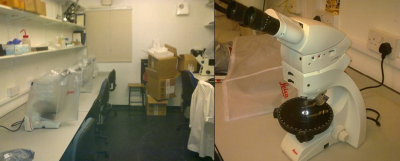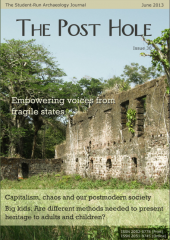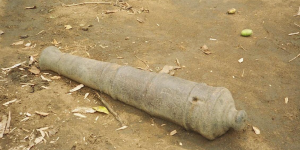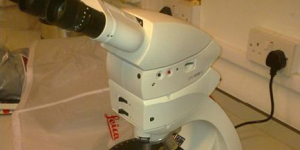Most archaeologists are aware that what we can see in the field is only a fraction of the archaeological record. This is perhaps especially obvious to anyone who has excavated a Near Eastern tell site, ashy midden deposits, or multiple superimposed hearth deposits in caves. The photograph in Figure 1, showing hundreds of finely stratified layers in a midden at the Neolithic site of Çatalhöyük (Turkey) illustrates this quite nicely.
Although single-context archaeology is often regarded as a ‘gold standard’ in excavation methodology (for a great discussion of this see Colleen Morgan’s blog; Morgan 2010), excavating a true ‘single’ context is limited firstly by our ability to visually resolve an individual layer, and secondly by our tools. I remember during one field season, Shahina Farid (former field director of the Çatalhöyük Project and Senior Research Associate at UCL) remarked that we can only dig at the resolution that a trowel will allow. You could even say, thirdly, that we are limited by time - how long would it take to excavate multiple single layers, less than 1mm thick, or to sieve these deposits to recover remains such as charred plants and animal bones? In reality therefore, we have to assign artificial ‘single’ contexts to these types of complex deposits.
Obviously there are problems here. How can we distinguish between individual daily activities if we group together multiple layers from several events, artificially labelled as a single unit? As discussed by Goldberg et al. (2009), if we are to move beyond broad interpretations of human behaviour, we need to examine the archaeological record on the scale at which human activities occur and are recorded – often this is the microscale. Daily activities produce signals which may be all but invisible to the naked eye, but which can be seen clearly by looking at deposits under the microscope.
One approach which addresses this problem is through the application of ‘microarchaeology’. This term was used by Weiner (2010) to describe a combination of microanalytical techniques that aim to examine past human activity at a high spatial and temporal resolution. The past few decades have seen a steady increase in the application of these microanalytical methods to archaeology, many of which were first developed outside the discipline, for example in soil science or geology (Matthews et al. 1997).
In the past few years in particular, methods such as thin section micromorphology, combined with microbotanical and geochemical analyses, have become increasingly recognised as providing an essential insight into several aspects of the archaeological record. An example of the resolution of this approach is the identification of individual layers of wall plasters at the site of Çatalhöyük in Turkey, revealing the seasonal redecorating habits of the Neolithic population (Matthews 2005).
Similarly, we can identify single episodes of dust accumulation on floors, where microscopic debris became trapped underneath matting - a scenario familiar to anyone who has swept underneath a rug on hard flooring (Figure 2). And it is not just in buildings - this approach can also be used to identify formation processes of midden deposits (Shillito 2011; Shillito et al. 2011).
However, microscopic analysis still has its limitations. We can only identify activities which leave a visual signal, and even then there are some materials, particularly organic remains, which are almost impossible to identify using visual methods. By combining the microscopic analysis with chemical analysis, we can overcome this problem.
Chemical analysis can be divided broadly into inorganic and organic methods. Inorganic methods include techniques such as infra-red spectroscopy (FT-IR) and X Ray Fluorescence (XRF), which can characterise the elemental and structural composition of materials such as mudbricks, plaster and stone. Organic techniques include Gas Chromatography Mass Spectrometry (GC/MS), which separate out and identify different components in complex mixtures of organic materials such as fats, oils and resins. Although organic techniques are more time consuming and expensive, the information they can provide is much more specific and in many cases can identify the exact origin of decayed material, for example distinguishing between layers of trampled animal dung and human latrine deposits (Shillito et al. 2011).
Microarchaeology at the University of York
The Department of Archaeology in York has several strengths, but is particularly strong in the fields of bioarchaeology and cultural heritage management, with period strengths in early prehistory and historical archaeology. In addition to this, the department is committed to the integration of humanities and science-based approaches in all aspects of the discipline.
The application of organic geochemical techniques is well established at the University of York, and is one of the major research areas of the BioArCh group. BioArCh have applied GC/MS and associated methods particularly to pottery samples, where they have been used recently to identify the types of foods that were being processed in Jomon pottery (Craig et al. 2013). With pottery analysis, we can combine the analysis of ‘invisible’ chemical residues with microscopic analysis of plant remains in burnt food crusts, to provide a more complete picture of what the vessels may have been used for (Saul et al. 2012).
This ‘microarchaeological’ approach is being further developed through major research projects in the Department, such as the ERC InterArchive project (investigating microscopic and geochemical signals in burials), and is also included as an important part of the ERC POSTGLACIAL project at the Mesolithic site of Star Carr. The Department Research Committee has also supported the development of this methodology through funding pilot projects at important prehistoric sites such as Paisley Caves (USA) and Çatalhöyük (Shillito and Ryan in press).
Learning and teaching – the importance of practical approaches
Thanks to generous funding from the University Teaching Committee, the Department of Archaeology in York is now able to offer students access to facilities and training in this area, through a new microscope facility based in the BioArCh laboratories (Figures 3 and 4). ‘Archaeology Under the Microscope’ is a strategic learning and teaching project which aims to build upon existing strengths in the Department.
In response to module evaluation data, it was recognised that a key skill area, training in the use of modern microscopic facilities, was an under-represented area in the teaching of archaeological science and laboratory skills. The aim of ‘Archaeology Under the Microscope’ is to address this through developing a state of the art microscope laboratory and digital reference collection that can be used for teaching across undergraduate and postgraduate curricula, enabling students to become more involved in departmental research.
The importance of practical laboratory teaching in science subjects is well documented (Hofstein and Lunetta 2004), and competency in practical skills is also shown to be essential for employment in the archaeological workplace (Lydon 2002; Croucher et al. 2008). An integrated approach of practical microscopy training and digital image resources was used for example by Kumar et al. (2006) in teaching histology, and evaluation indicated that students strongly supported this integrated approach. The project produced a collection of reference images that could be accessed remotely by students, enabling them to revise materials demonstrated during practical sessions, in their own time.
A similar collection of reference images are currently being produced in York alongside a physical collection of microscope slides. These images will be archived with the York Digital Library (YODL), an online repository for multimedia resources at the University of York. YODL provides access to over 69,000 resources, including images, past exam papers and theses. The reference collection will be permanently available with YODL to support research, teaching and study in archaeology and beyond.
Reference materials have been selected to complement existing teaching within the Department of Archaeology (including pottery and bone thin sections), as well as areas of current research (such as microfossil analysis) to enable new teaching to be developed in this area in future. The project was recently presented at the University Learning and Teaching Conference 2013 (Figure 5), and the microscopes are now available for use in student projects.
It is hoped that this facility will provide a foundation that can be built upon in the future, and become an important teaching and research resource that will keep York at the cutting edge of archaeological investigation. Further information and case studies can be found on the author’s blog at: http://castlesandcoprolites.blogspot.co.uk/.
Bibliography
- Craig, O.E., Saul, H., Lucquin, A., Nishida, Y., Taché, K., Clarke, L., Thompson, A., Altoft, D.T., Uchiyama, J., Ajimoto, M., Gibbs, K., Isaksson, S., Heron, C.P. and Jordan, P. (2013) ‘Earliest evidence for the use of pottery’. Nature. 496 (7445). 351-354
- Croucher, K., Cobb, H. and Brennan, A. (2008) Investigating the role of fieldwork in teaching and learning archaeology. Liverpool: Higher Education Academy Subject Centre for History, Classics and Archaeology
- Hofstein, A. and Lunetta, V.N. (2004) ‘The laboratory in science education: Foundations for the twenty-first century’. Science Education. 88 (1). 28-54
- Goldberg, P., Miller, C.E., Schiegl, S., Ligouis, B., Berna, F., Conard, N.J. and Wadley, L. (2009) ‘Bedding, hearths, and site maintenance in the Middle Stone Age of Sibudu Cave, KwaZulu-Natal, South Africa’. Archaeological and Anthropological Sciences. 1 (2). 95-122
- Kumar, R.K., Freeman, B., Velan, G.M. and De Permentier, P.J. (2006) ‘Integrating histology and histopathology teaching in practical classes using virtual slides’. The Anatomical Record Part B: The New Anatomist. 289 (4). 128–133
- Lydon, J. (2002) ‘Archaeology in the workplace: Teaching about the past in a changing world’, in S. Ulm, C. Westcott, J. Reid, A. Ross, I. Lilley, J. Prangnell and L. Kirkwood (eds.) Barriers, Borders, Boundaries: Proceedings of the 2001 Australian Archaeological Association Annual Conference. Brisbane: Anthropology Museum, University of Queensland. 7. 129-135
- Matthews, W. (2005) ‘Micromorphological and microstratigraphic traces of uses and concepts of space, in I. Hodder (ed.) Inhabiting Çatalhöyük: Reports from the 1995-1999 seasons. Cambridge: McDonald Institute for Archaeological Research. 355-399
- Matthews, W., French, C.A.I., Lawrence, T., Cutler, D.F. and Jones, M.K. (1997) ‘Microstratigraphic traces of site formation processes and human activities’. World Archaeology. 29 (2). 281-308
- Morgan, C. (2010) ‘Where is single context archaeology?’. Middle Savagery. Available at: http://middlesavagery.wordpress.com/2010/02/23/where-is-single-context-a... [Accessed 3rd May 2013]
- Saul, H., Wilson, J., Heron, C.P., Glykou, A., Hartz, S. and Craig, O.E. (2012) ‘A systematic approach to the recovery and identification of starches from carbonised deposits on ceramic vessels’. Journal of Archaeological Science. 39 (12). 3,483-3,492
- Shillito, L-M. (2011) ‘Çatalhöyük: Neolithic diets and debris under the microscope’. Current World Archaeology. 47. Available at: http://world-archaeology.com/features/turkey-neolithic-life-at-catalhoyuk/ [Accessed 3rd May 2013]
- Shillito, L-M., Matthews, W., Bull, I.D. and Almond, M.J. (2011) ‘The microstratigraphy of middens: Capturing daily routine in rubbish at Neolithic Çatalhöyük, Turkey’. Antiquity. 85 (329). 1,024-1,038
- Shillito, L-M. and Ryan, P. (in press) ‘Surfaces and streets: Phytoliths, micromorphology and changing use of space at Neolithic Çatalhöyük (Turkey)’. Antiquity
- Weiner, S. (2010) Microarchaeology: Beyond the Visible Archaeological Record. Cambridge: Cambridge University Press












